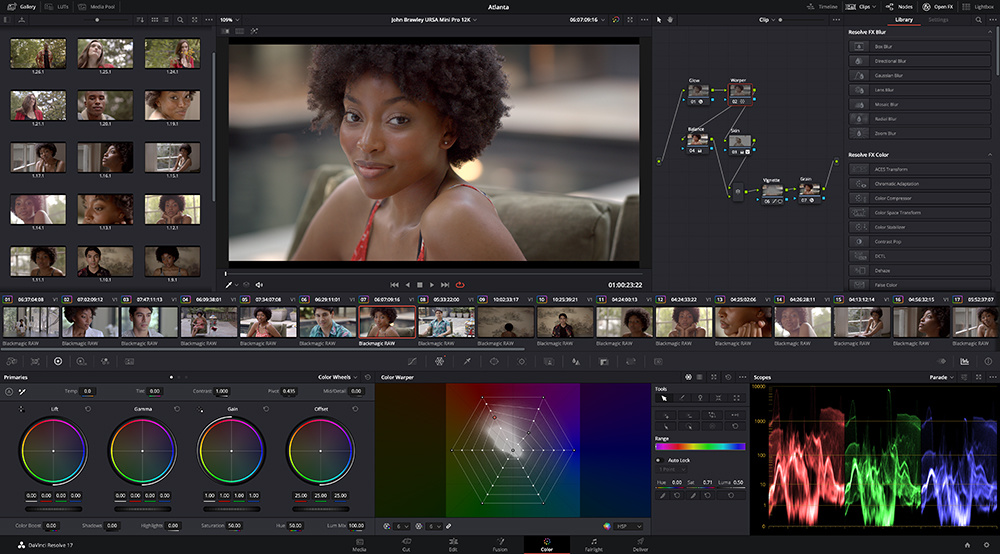Color Matching and Correction: Achieving Cinematic Excellence with DaVinci Resolve

In the vast tapestry of visual storytelling, color plays a pivotal role in shaping the mood, tone, and atmosphere of a film or video project. From the vibrant hues of a tropical paradise to the moody shadows of a film noir thriller, color serves as a powerful tool for evoking emotion, enhancing storytelling, and creating visual cohesion. DaVinci Resolve, renowned for its industry-leading color grading capabilities, offers a comprehensive suite of tools and features for color matching and correction, empowering filmmakers, editors, and colorists to achieve cinematic excellence and bring their creative vision to life. In this extensive guide, we’ll delve into the realm of color matching and correction within DaVinci Resolve, exploring the strategies, techniques, and best practices for achieving stunning visuals and captivating audiences.
Introduction to Color Matching and Correction in DaVinci Resolve
Color matching and correction stand as essential steps in the post-production process, allowing filmmakers and editors to fine-tune the color palette of their projects, correct inconsistencies, and achieve visual consistency across different shots and scenes. Whether working on a feature film, commercial, or web video, DaVinci Resolve provides a comprehensive set of tools and features for color matching and correction, enabling users to achieve cinematic excellence and elevate the visual quality of their projects.
Understanding Color Matching and Correction
At its core, color matching involves ensuring consistency in color and tone across different shots and scenes within a project. This may involve matching the color balance, exposure, contrast, and saturation of shots to create a seamless visual flow and maintain continuity throughout the film or video.
Color correction, on the other hand, involves adjusting the color balance, exposure, contrast, and saturation of individual shots to achieve a desired look or aesthetic. This may include correcting white balance issues, adjusting exposure levels, enhancing contrast, and fine-tuning color saturation to achieve a balanced and visually pleasing image.
Tools and Techniques for Color Matching and Correction
DaVinci Resolve offers a wide range of tools and techniques for color matching and correction, empowering users to achieve precise control over the color and tone of their projects. Some of the key tools and features include:
- Primary color correction: Allows users to adjust the overall color balance, exposure, contrast, and saturation of a shot using basic controls such as lift, gamma, and gain.
- Secondary color correction: Enables users to target specific colors within a shot and make adjustments to hue, saturation, and luminance using masks and qualifiers.
- Color grading panels: Provides dedicated hardware control surfaces that allow users to manipulate color and tone using physical knobs, buttons, and sliders for a more tactile and intuitive editing experience.
- Color management: Offers robust color management tools and features for managing color spaces, gamma curves, and color profiles to ensure accurate color reproduction across different devices and platforms.
Advanced Color Matching Techniques
In addition to basic color correction tools, DaVinci Resolve offers a range of advanced techniques for achieving precise color matching and correction. These include:
- Color matching: Allows users to automatically match the color and tone of one shot to another using reference frames, color charts, or predefined looks.
- Shot matching: Enables users to match the color and tone of shots within a sequence using automated tools and algorithms based on visual similarities and reference frames.
- Scene detection: Automatically detects scene changes within a video clip and applies color corrections and adjustments to maintain consistency across different shots and scenes.
- LUT support: Provides support for Look-Up Tables (LUTs) for applying predefined color grading looks and styles to footage, allowing users to achieve consistent color grading across different projects and platforms.
Best Practices for Color Matching and Correction
Achieving cinematic excellence with color matching and correction requires a combination of technical expertise, artistic vision, and attention to detail. Some best practices for color matching and correction in DaVinci Resolve include:
- Use reference frames: When color matching shots, use reference frames or color charts to ensure accurate color reproduction and consistency across different shots and scenes.
- Start with primary correction: Begin by making broad adjustments to the overall color balance, exposure, contrast, and saturation using primary color correction controls before moving on to more specific adjustments.
- Use scopes: Utilize waveform monitors, vectorscopes, and other visual aids to analyze the color and tone of your footage and make informed decisions when making color corrections and adjustments.
- Experiment with different looks: Don’t be afraid to experiment with different color grading looks, styles, and techniques to achieve the desired aesthetic for your project. DaVinci Resolve offers a wide range of creative tools and features for achieving unique and visually stunning results.
Conclusion: Elevating Visuals with DaVinci Resolve
In conclusion, color matching and correction in DaVinci Resolve offer filmmakers, editors, and colorists a powerful toolkit for achieving cinematic excellence and bringing their creative vision to life. Whether working on a feature film, commercial, or web video, DaVinci Resolve provides the tools, flexibility, and precision needed to achieve stunning visuals and captivate audiences.
By understanding the principles of color matching and correction, leveraging the tools and features available in DaVinci Resolve, and adhering to best practices, users can achieve precise control over the color and tone of their projects, maintain consistency across different shots and scenes, and ultimately deliver visually stunning and engaging content that leaves a lasting impression on audiences.




